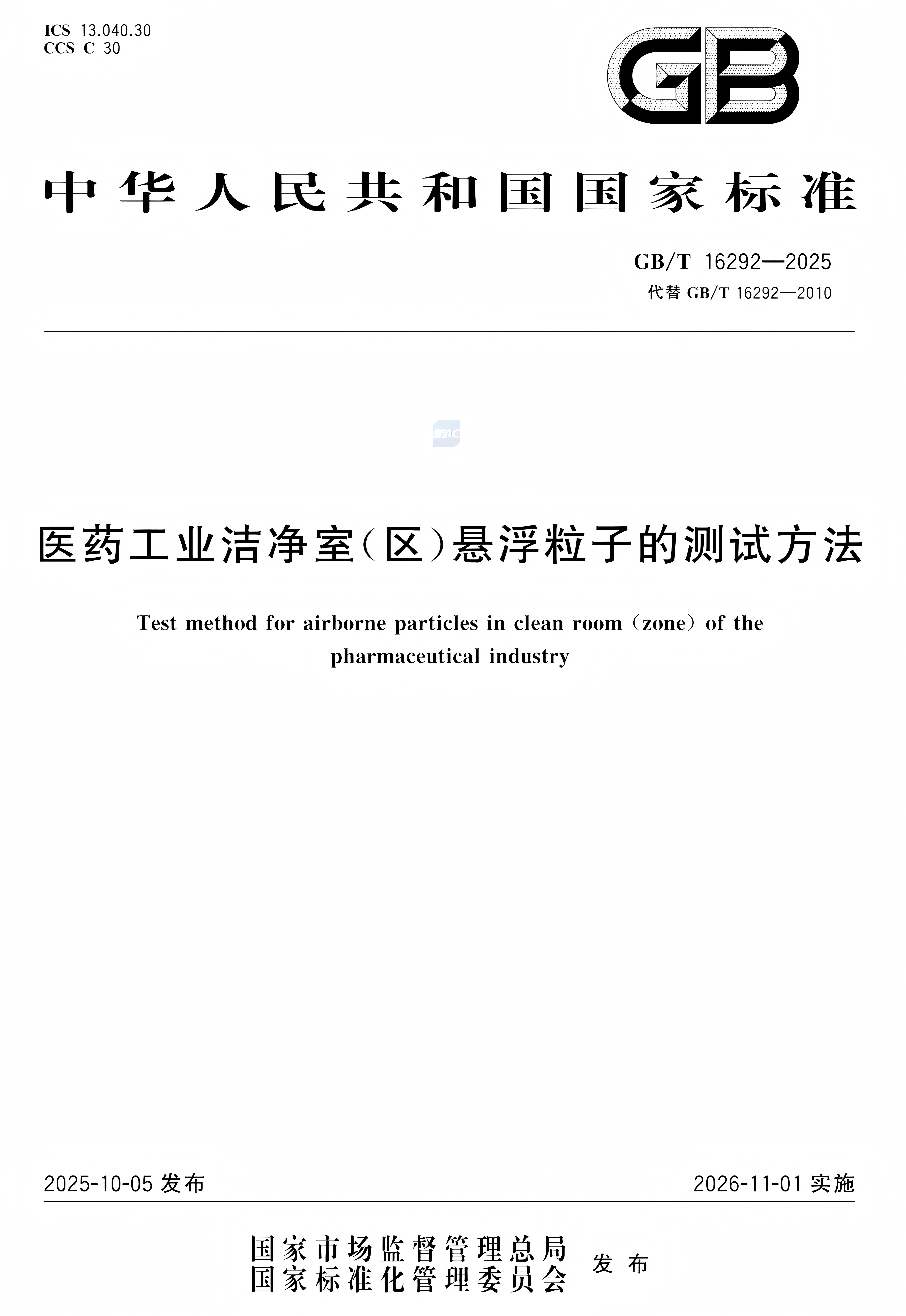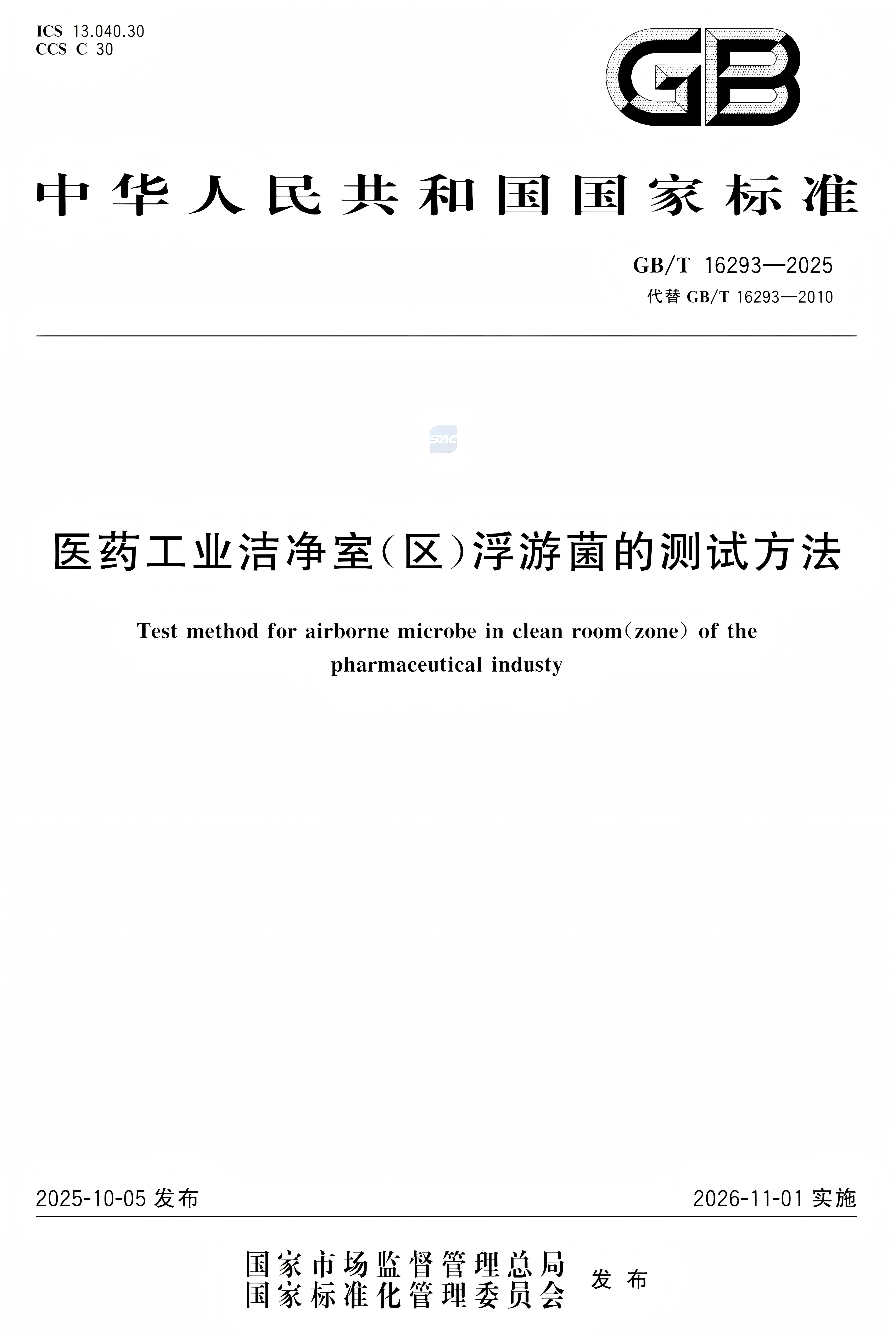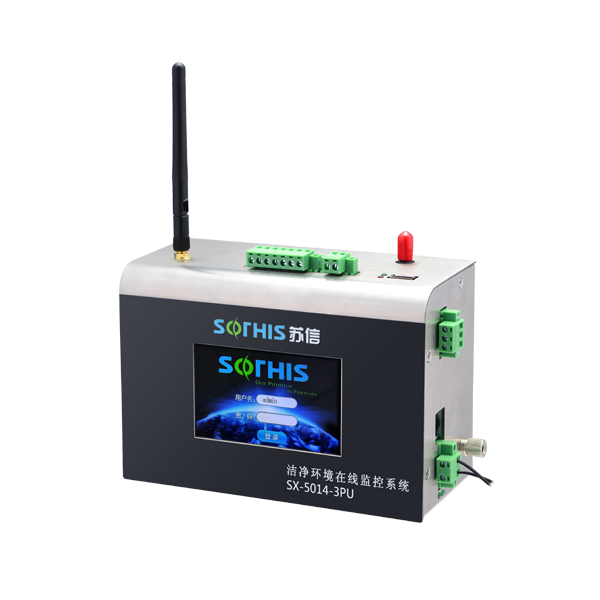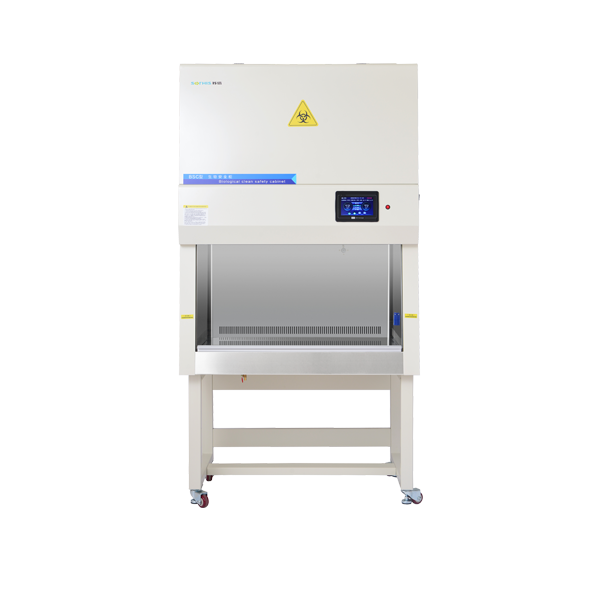The degree of dust content in the air (i.e. dust concentration) determines the cleanliness of the area.
Recently, the National Standards Committee officially released the new version of GB/T 16292-2025 "Test Method for Suspended Particles in Cleanrooms (Areas) of the Pharmaceutical Industry" and GB/T 16293-2025 "Test Method for Floating Bacteria in Cleanrooms (Areas) of the Pharmaceutical Industry". Both documents have undergone significant adjustments, with the following specific changes:
GB/T 16292-2025
Test Method for Airborne Particles in Clean room (Zone) of the Pharmaceutical Industry

1. New content: Added the working principle and schematic diagram of the instrument, and refined the description of the working principle of the instrument.
2. Method change: The suspended particle testing method has been updated.
3. Sampling requirements adjustment:
• Changed the minimum number of sampling points, sampling point positions, and single sampling volume.
• The limit on the number of sampling times has been removed, but the sampling time requirements for each sampling point have been added.
4. Calculation and evaluation changes:
• The requirements and calculation methods for standard deviation and 95% confidence upper limit have been removed.
• Added a calculation method for particle concentration per cubic meter.
• The result evaluation section has been deleted.
5. Report and chapter adjustments:
• Changed the requirements for the 'test report'.
• Added a chapter on suspended particle monitoring.
• The appendix "Layout of Sampling Points in Cleanrooms (Areas)" has been deleted.
GB/T 16293-2025
Test Method for Airborne Microbe in Clean room (Zone) of the Pharmaceutical Industry

Testing method for planktonic bacteria:
1. New content:
• Added a description of the working principle of the planktonic bacteria sampler.
• Increased requirements for the culture medium.
• Added minimum sampling requirements for different cleanliness levels.
2. Sampling and cultivation adjustment:
• Changed the requirements for sampling points.
• Changed the cultivation counting requirements.
3. Chapter deletion:
• The section related to 'result evaluation' has been deleted.
• The chapter on 'Daily Monitoring' has been deleted.
• The section on "Layout of Sampling Points in Cleanrooms (Areas)" has been deleted.
• The section on sterilization and preparation of culture medium has been deleted.
Let's take a look at the development history of cleanliness standards:
In 1961, the world's first unidirectional flow clean room was born, and at the same time, the world's first cleanliness standard, AF Technical Order 203, was introduced, which was also the cornerstone of the US Federal FS-209 standard.
In 1963, the US Federal Standard FS-209 was promulgated and implemented, becoming the internationally recognized cleanroom standard. With the development of clean technology in various countries, the higher requirements for air cleanliness encountered in the use of the 209 standard, especially in the microelectronics industry, have prompted continuous revisions to the 209 standard (FS-209A/B/C/D/E). The final 209E standard divides cleanrooms into levels 1, 10, 100, 1000, 10000, and 100000 based on particle concentration per cubic foot (ft3).
The FS-209 standard proposes that when the total sampling points are less than 10, repeated sampling should be used for statistical 95% confidence level (UCL) calculation to make the evaluation results more realistic and accurate.
In 1992, when China first issued the GMP standard, due to the fact that domestic clean technology was still in its infancy, adopting internationally recognized standards was convenient for equipment procurement and technology introduction. In the early days, the Chinese pharmaceutical industry needed to enter the international market through GMP certification, so the FS-209B standard was used for clean room classification at that time.
In 1996, China launched the first national particle detection standard GB/T 16292-1996 "Test Method for Suspended Particles in Cleanrooms (Areas) of the Pharmaceutical Industry", equivalent to FS-209E. The first batch of particle counters developed by SuXin Environment in China also emerged with this trend.
In 1998, China's first revised version of the GMP standard was issued, which added a level of 300000 in Appendix 1. It stipulated the requirements for static testing and dynamic monitoring of clean room management in aseptic production. In the second year, Su Xin Environment's first online monitoring system also followed the pace of the times and was officially launched.
In 1999, the International Organization for Standardization launched ISO 14644.1-1999 "Cleanrooms and Related Controlled Environments The first part of the "Classification of Air Cleanliness Levels Based on Particle Concentration" has been implemented, which unifies the concentration unit volume into metric units, cubic meters. Cleanrooms are classified into ISO 1-9 levels based on the concentration of particles of interest per m ³, and specifies the calculation of minimum sampling volume and sampling methods. The 95% confidence level (UCL) evaluation method is still used.
In 2001, FS-209E was abolished and ISO 14644.1 will become a future trend.
In 2010, China's revised GMP fully adopted the ABCD four level cleanliness standards recommended by the World Health Organization, corresponding to ISO 14644 levels 5 (A), 7 (B), 8 (C), and 9 (D). Simultaneously clarify the requirements for dynamic and static monitoring, and introduce microbial and pressure differential control. This is also a national regulatory pressure. Markets such as the European Union and the United States require compliance with WHO standards, which has promoted the upgrading of domestic GMP. ABCD grading more accurately matches the risk levels of different production processes (such as A-level used in sterile filling areas), strengthening risk control. The testing method for suspended particles in this version of GMP standards has referred to the more scientific ISO 14644.1 standard.
In the same year, GB/T 16292-2010 "Testing Methods for Suspended Particles in Cleanrooms (Areas) of the Pharmaceutical Industry" abolished the 1996 version of the filter membrane microscope testing method due to the technological development of laser dust particle counters, and fully adopted the more convenient laser particle counting method to detect suspended particles. The statistical evaluation method continued to use UCL confidence level.
In the same year, China released GB/T 25915.1-2010 "Cleanrooms and Related Controlled Environments The first part of the classification of air cleanliness levels based on particle concentration adopts all the contents of ISO standards.
In 2015, ISO 14644.1 underwent significant revisions due to a reflection on the limitations of traditional UCL statistical evaluation methods. Firstly, the distribution assumption is not valid, and the particle concentration in clean rooms often exhibits a non normal distribution due to uneven airflow. The t-distribution coefficient of UCL (such as coefficient 6.31 when n=2) exaggerates uncertainty and increases the risk of misjudgment; Secondly, traditional methods require at least 2 sampling points and a total sampling frequency of ≥ 5 times, but there may be insufficient sampling points in small clean rooms (such as 10 square meters), resulting in UCL calculation bias and unreliable results in small samples. Thirdly, the detection equipment is constantly upgrading, the software of particle counters is becoming more intelligent, online particle counters are becoming popular, and real-time monitoring at multiple points is supported, providing a data foundation for calculating the average value. The 2015 version of the ISO standard proposes the concept of "dynamic monitoring", emphasizing the importance of real-time data and weakening the statistical significance of single detection.
In 2021, China's GBT 25915.1 "Cleanrooms and Related Control Environments Part 1: Classification of Air Cleanliness Levels Based on Particle Concentration "has been updated with the 2015 version of the ISO standard, with only slight changes made to the confirmation of the number of sampling points for large-scale and ultra large scale cleanrooms unique to China.
In 2022, the revised version of Appendix 1 of the EU GMP requires the use of "continuous monitoring+trend analysis" to gradually phase out static determination of UCL.
In 2024, the draft GBT-16292 for soliciting opinions has abolished UCL determination and fully refers to ISO standards.
In 2025, the 25th edition of the Pharmacopoeia of the People's Republic of China will be released, which includes the Guiding Principles for Microbial Testing and Control in Pharmaceutical Cleanrooms 9205 in Part Four. The determination of suspended particle monitoring results will also be fully implemented in accordance with ISO standards.
At this point, the UCL evaluation method for cleanliness confidence will officially come to an end in the near future.
Summary: From FS-209 to ISO14644, UCL was once a core tool for cleanliness assessment, but its limitations have become increasingly prominent with technological advancements such as online monitoring and a deeper understanding of particle distribution patterns in cleanrooms. The implementation of the Pharmacopoeia in 2025 marks the complete withdrawal of UCL evaluation methods, replaced by a scientific model of dynamic monitoring and trend analysis.



